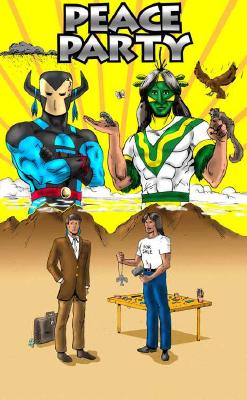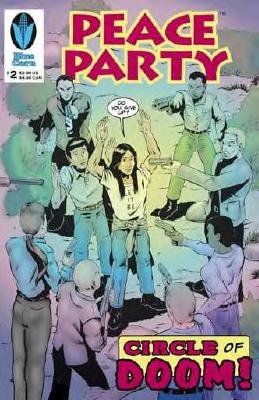|
 When Drew
Quyatt, also called Snake Standing, and Billy Honanie, known as Rain Falling, were confronted with a group of bad
guys with guns, they didn’t respond the traditional superhero way, with super-powered punches or laser eye beams. When Drew
Quyatt, also called Snake Standing, and Billy Honanie, known as Rain Falling, were confronted with a group of bad
guys with guns, they didn’t respond the traditional superhero way, with super-powered punches or laser eye beams.
They sent rattlesnakes—and ran.
The newest comic to hit the shelves is "Peace Party," a comic book with Native American superheroes that
does just what its title implies: promote peace.
The two heroes for "Peace Party" are Drew a reservation-raised Native American,
and Billy a Native American lawyer—two cousins from different upbringings thrown together after a visit from a
supernatural being, when they are imparted with supernatural powers.
In an effort to balance the traditions of their pasts with modern society, these two protagonists use nature and
the elements to combat evil.
"Peace Party" is unique in many ways. A portion of the profits from sales of the comic book have been
designated, by Blue Corn Comics, for Native organizations such as the American Indian College Fund.
Additionally, Peace Party has a board of advisors. This board of Native American experts
reviews each script for accuracy and sensitivity to Native concerns. This plain commitment to quality is unprecedented
in a comic book. These experts, and other Native people who have seen PEACE PARTY, are available to explain the
need for its alternative perspective.
Perhaps advisor Joseph Riverwind explains it best:
"Peace Party takes you back to the comic books of the old days, where the story had
as much weight as the drawings. They went hand in hand as they took the reader through the struggles the superheroes
were going through without the cursing, sex and violence which is mainstream in today's society.
The cultural benefit is tremendous! Our Native youth have few people to look up to. Many of us as children wanted
to be like the superheroes that we saw on TV or read in comics. For those of us who are Native, it never occurred
to us that we weren't the right color or that our lives weren't like those of the hero's.
Peace Party not only has Native American superheroes but they are dealing with issues that we encounter every day.
What better way for our youth to learn how to handle problems than non-violently? Peace Party shows this to the
reader, as well as the struggles that we face which the children do not understand yet, but they hear the adults
speaking of these things, the coal mining, the internal struggles of living in a modern world yet holding on to
our traditions. Peace Party puts Native issues in a form that our youth can understand and relate to.
For non-Native readers Peace Party offers an insight into the ways of life of the Southwestern people. This is
great because it begins to destroy all those old stereotypes that still exist to day."
Joseph Riverwind (Creek/Seminole)
A message from the publisher to teachers:
 As the publisher
of PEACE PARTY, I'd like to find ways to work with you and your class. I plan to write a teaching guide listing
projects and activities, but here are some preliminary suggestions: As the publisher
of PEACE PARTY, I'd like to find ways to work with you and your class. I plan to write a teaching guide listing
projects and activities, but here are some preliminary suggestions:
One possibility is to participate in the monthly stereotype contest I've started. Your kids could look up the stereotypes
I've listed, report on them, and submit their own examples for posting.
Another possibility is research projects. Students could examine one of the comic's plot points and write reports
on it. As an example, Billy and Oliver articulate two different views of the law in PEACE PARTY #1, page 4. You
could ask your students what each character meant, which view they thought was "right," and why.
Your students could write short PEACE PARTY stories or illustrate some of the text features I've created. I could
"publish" the best student work online. Or they could invent plausible "histories" (biographies)
for the characters. They might need more stories to do either of these, so these could be long-term projects.
Your kids could try translating PEACE PARTY into their native language—with help, of course.
We could hold a contest in which the child who did something noteworthy (read the most books?) got to appear as
a character in an upcoming story. Or earned a special page on the PEACE PARTY website. Or won a free comic book.
Your students could undertake a public letter-writing campaign based on an issue in the comic. Stop wasting water
from the Colorado Plateau's N-Aquifer or free Leonard Peltier (in PEACE PARTY #2), for instance.
You could study how the media would report the first two issues's events. Your charges could write news summaries
of these events, then compare them to the article I've written and posted online.
Or the kids could write letters on what they thought of the comic and I could post them online.
 If you ever discuss Indian portrayals in the media (historical flaws vs. reality), please check
out my Indian Comics Irregular newsletter. I try to mention prominent appearances of Indians in the popular media:
movies, video games, cartoons, comics, and so forth. For example, in March 2000 I did a review of the Pocahontas
II video and commented on its historical accuracy—or lack thereof. If you ever discuss Indian portrayals in the media (historical flaws vs. reality), please check
out my Indian Comics Irregular newsletter. I try to mention prominent appearances of Indians in the popular media:
movies, video games, cartoons, comics, and so forth. For example, in March 2000 I did a review of the Pocahontas
II video and commented on its historical accuracy—or lack thereof.
These are just a few of the many possibilities. The key advantage of comics in the classroom is their entertainment
value. Kids consider comic books fun compared to textbooks or novels. They can dip in and out of them without becoming
intimidated by pages of prose.
Yet a comic like PEACE PARTY has enough substance to build lessons around. In that sense, it joins products such
as Tony Hillerman's mysteries in making Native culture broadly accessible. These are useful tools for increasing
public awareness of the indigenous people among us.
PEACE PARTY’s audience is readers of graphic literature, especially teens, young adults, and adults. It’s aimed
at those who want more sophisticated, challenging stories than those in most comic books. A market for such fare
exists, but most of the existing products in this category are either dark and nihilistic or escapist fantasies.
Few touch upon current political, social, or cultural issues.
Robert Schmidt
Find out even more about Peace Party and how to get your own copy at
their site:
Peace Party
http://members.xoom.com/peaceparty/
|
 When Drew
Quyatt, also called Snake Standing, and Billy Honanie, known as Rain Falling, were confronted with a group of bad
guys with guns, they didn’t respond the traditional superhero way, with super-powered punches or laser eye beams.
When Drew
Quyatt, also called Snake Standing, and Billy Honanie, known as Rain Falling, were confronted with a group of bad
guys with guns, they didn’t respond the traditional superhero way, with super-powered punches or laser eye beams. As the publisher
of PEACE PARTY, I'd like to find ways to work with you and your class. I plan to write a teaching guide listing
projects and activities, but here are some preliminary suggestions:
As the publisher
of PEACE PARTY, I'd like to find ways to work with you and your class. I plan to write a teaching guide listing
projects and activities, but here are some preliminary suggestions: If you ever discuss Indian portrayals in the media (historical flaws vs. reality), please check
out my Indian Comics Irregular newsletter. I try to mention prominent appearances of Indians in the popular media:
movies, video games, cartoons, comics, and so forth. For example, in March 2000 I did a review of the Pocahontas
II video and commented on its historical accuracy—or lack thereof.
If you ever discuss Indian portrayals in the media (historical flaws vs. reality), please check
out my Indian Comics Irregular newsletter. I try to mention prominent appearances of Indians in the popular media:
movies, video games, cartoons, comics, and so forth. For example, in March 2000 I did a review of the Pocahontas
II video and commented on its historical accuracy—or lack thereof.